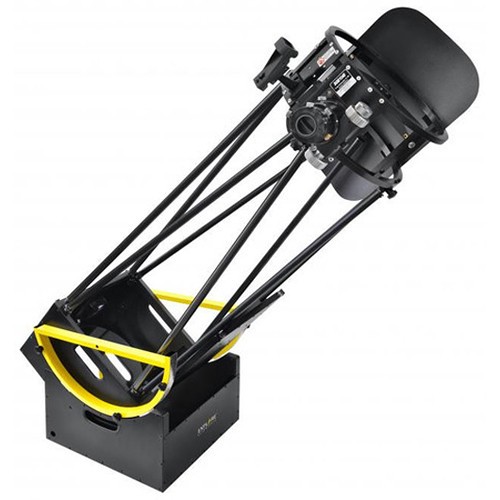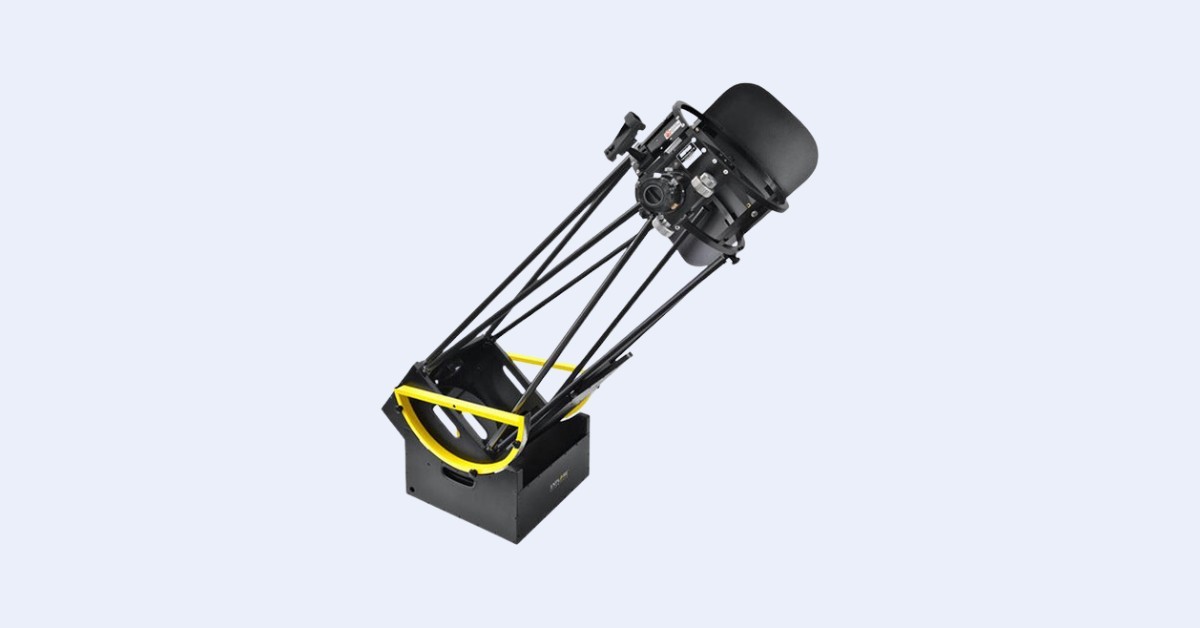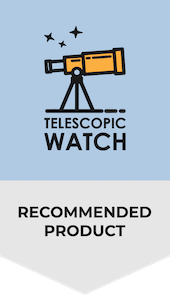Decoding The Truss Tube Design for Beginners
The Explore Scientific 10” Truss Dobsonian, is, as the name implies, a truss tube telescope. In the past, almost all commercial Dobsonians were what’s known as “solid tubes.” A solid tube telescope is one where the tube that holds the mirrors is completely solid, typically metal or, in some cases, wood. A truss-style telescope is almost completely different, as it is constructed with truss poles. This means that there is no tube at all.
A truss telescope consists of four major parts: the base/rocker box, the mirror box, the truss poles, and the upper tube assembly.

The rocker box in a truss telescope is the part that contains the bearings to move the telescope up, down, left, and right, and it is what the telescope sits on. Because the truss telescope design has a much different center of gravity, the rocker box can be very short. Unlike many mass-manufactured truss telescopes, the ES 10” Truss uses a square lower tube assembly, much like premium and homemade instruments usually do. It’s also almost entirely made out of aluminum, with no wood or plastic to be found.
Next is the mirror box, and it is, as the name implies, where the main mirror is located. The mirror box is typically very short because it only serves to hold the mirror in place and collimate the mirror. The mirror box is where the altitude bearings attach as they pivot up and down. The truss poles attach to the top of the mirror box. The mirror box is entirely aluminum and contains two cooling fans. Like the mount, the mirror box is held together solely by rivets, which is pretty unusual and reminds me of an aircraft.
The upper tube assembly sits on top of the truss poles, and it holds the secondary mirror, finderscope, and focuser of the telescope. Typically, the upper tube assembly is formed of two lightweight rings with struts in between, as you will find on this telescope. The upper tube assembly is also very light, as it is almost completely hollow while still being quite strong.
The truss poles are the main feature of a telescope like this. Truss poles replace the typically very heavy metal tubes that become impractical for large telescopes, and they make the telescope far more portable. Truss poles are the set of eight poles that form a triangular shape (hence the name “truss”) and make the telescope extremely rigid-perhaps more rigid than a closed tube telescope. The truss poles detach from the upper and lower sections of the telescope easily, leaving only the lower and upper tube assemblies, which themselves are very small. The poles make up the bulk of the telescope’s length but are quite small. These factors make truss telescopes extremely portable and lightweight.
The Optical Tube Assembly
The Explore Scientific 10” Truss Dob’s primary mirror has a diameter of 250 mm, or 10 inches.
The ES 10” has a focal length of 1250mm, which is f/5 when you consider the 10-inch primary mirror. f/5 is a decent speed for a 10-inch telescope, as it is usable for both planetary and deep-sky observing comfortably while still being short enough to use without a ladder. Because of that, the f/5 focal ratio also does not create as much coma as a faster mirror, and because of that, you do not need an expensive coma corrector to remove distracting aberrations.
The top cover for the mirror box is square and hinged. You tuck it out of the way and secure it to the scope’s altitude bearings (themselves detachable) when in use. It is convenient, but not exactly well-designed. Without any sort of baffling on the mirror box, it’s easy for stray light to get in, and there’s nothing to protect the mirror while you install the truss poles.
The 8 trusses bolt onto each corner on the inside using thumbscrews. Unlike the collimation rod, these poles do not have any sort of safety rubber and will damage your primary mirror if they are knocked, scraped, or dropped onto it—a significant risk both when setting up and dismantling the scope. Making a makeshift cardboard, plastic, or fabric cover or simply draping a towel over the mirror during setup is a really good idea.
The upper tube assembly bolts atop the truss poles with a couple of hand knobs, a relatively easy task. The UTA only has baffling directly across from the secondary, which can lead to issues with light getting in the tube. For best results, we’d recommend adding foam or black plastic to the entire periphery of the upper tube assembly, as well as purchasing Explore Scientific’s light shroud unit for the telescope. A shroud is a large piece of fabric that goes around the truss poles and blocks any light that would ruin views. The shroud can help deter dew, but it is most important if you observe in areas that have bright streetlights that could seriously impact viewing if they shone directly onto the primary mirror. However, it is an additional expense you’ll have to factor in when purchasing this scope.
Accessories Included
The only actual accessory included with any of the Explore Scientific Truss Dobsonians is an abysmal red dot finder. The red dot finder included projects a simple red dot onto a glass screen, which you look through and center the target you wish to view in the red dot. It’s hard to adjust, doesn’t stay aligned, and the window is actually tinted, making the whole affair marginally better than just sighting down the tube. A better finderscope is basically required to use the telescope, along with, of course, a couple of eyepieces.
The dob includes a high-quality 2-inch Crayford focuser, which is fairly high quality and smooth and accepts 2-inch eyepieces and 1.25-inch eyepieces with no trouble. The focuser includes a dual-speed knob, which allows you to focus more finely. It works very well and would easily cost a couple of hundred dollars by itself if sold separately.
The telescope includes mirror cooling fans that are incorporated into the box. These fans allow you to cool the mirror quite quickly at night, so the views are not compromised by a changing mirror shape. Fans also have the advantage of blowing away any would-be dew that could land on the mirror surface, ruining views.
Explore Scientific 10″ Truss Tube Mount
The ES 10” truss Dob is a standard Dobsonian design but more closely resembles the premium Dobsonians devised by David Kriege back in the 1990s. It uses a pair of large, semi-circular altitude bearings with a pebbled glass board for moving in altitude and a glass board for azimuth motion—both on Teflon. The large altitude bearings keep the center of balance from shifting when you swap out eyepieces and accessories, though the scope is inherently top-heavy, so much so that you probably want Explore Scientific’s counterweights or to rig up a DIY counterweight system if you plan on using 2” eyepieces, a better finder, and/or a shroud (all of which are really good ideas). Like the tube, the entire mount is made out of aluminum sheet held together by rivets, with the altitude bearings made of solid cast aluminum.
Setting up the Truss Dob
The Explore Scientific 10” Dob, being a truss tube, has some fairly major changes in operation compared to other telescopes but also includes a novel form of collimation. Here I will go over the whole process of operations needed to set up this telescope and the front collimation feature. The ease of setup is what makes the truss-style tube an interesting alternative to solid tube telescopes, even if it needs more setup steps.
The ES10 begins with laying down the mirror box. Then, you attach the altitude bearings. These bearings can be taken off, which makes them easier to move because they are so big, especially the extra-large ones on this telescope. You can mount the altitude bearings at different positions to take different eyepiece weights into account so the telescope does not become unbalanced.
Next, you install the truss poles at four locations on the mirror box. The truss poles come in pairs, so they stay together reasonably well in transport. If you use the same poles at the same locations, you can reasonably maintain collimation when taking down and setting up the telescope. The poles are attached with easy-to-use thumbscrews.
Next, the upper tube assembly is attached to the top of the four truss poles, also with thumbscrews. At this point, the actual assembly is complete.
Then comes the collimation of the mirrors. A feature found in the Explore Scientific line of truss telescopes is that the primary mirror is collimatable from the front of the telescope. This means that you no longer have to reach to the back of the telescope, risking bumping it, and walk back and forth between the eyepiece and the mirror box.
But this collimation process is a bit unusual; you stick a long supplied rod down into the mirror box, grab onto a collimation screw, and turn it (as opposed to turning knobs on the back of the mirror box). This allows you to collimate the scope while looking through the eyepiece, which in theory makes collimation easier with a cap or Cheshire. However, in practice in the dark, there’s quite a risk of accidentally hitting the mirror with the rod, which, while rubber-coated, still probably shouldn’t be bumping into the reflective surface. This arguably negates the slight practical benefit of the whole system (using a laser collimator would also make it sort of pointless).
Like the primary mirror, the secondary collimation screws on the ES 10” are a little unusual, as they’re at a right angle to what most scopes come with. For beginners, you might not even notice this; experienced Newtonian users may be a little disoriented.
Alternative Recommendations
The Explore Scientific 10” Truss Tube Dobsonian is a great telescope as well as extremely portable, though you certainly aren’t getting a lot of aperture or features for the price tag.
I think the ES 10” Truss Dob isn’t for everyone, and one might consider some other scopes with slightly different features, perhaps a little faster or easier to assemble, and maybe with some more stuff included in the base price. Most Explore Scientific telescopes tend to be a little more a-la-carte than other brands’ offerings, a concession made to keep prices low and attention on the telescopes themselves rather than their accouterments.
If you want a truss tube, there are a few other options at the same price as the ES 10”. The Meade 10” Lightbridge Plus is still a truss, but it’s a bit more well-accessorized than the ES from the start, albeit a bit less compact and with a heavy and bulky particleboard base. It is also a little less delicate, with a more robust framework than the ES. The Sky-Watcher 10” Collapsible is yet another step towards simplification, with a simple collapsing tube and no truss poles or knobs to fiddle with, but lacks the dual-speed focuser of other offerings.
If a solid tube is more your thing, the GSO 10” Deluxe Dobsonian, sold as the Apertura AD10/Orion Skyline 10/Zhumell Z10, doesn’t feature any sort of collapsing or compactable tube, but it’s a fair bit cheaper and simpler, featuring a bunch of decent accessories thrown in to boot. The larger 12” model is about the same price as Explore Scientific’s 10” truss and offers a fair bit more light-gathering capability, but it’s a bulky and inconvenient thing the size of a water heater, and we’d really recommend you just step up to a 12” truss instead.
Under $1000
- The Apertura AD10/Zhumell Z10/Orion SkyLine 10 offers similar performance to the 10” Truss but with significantly better included accessories, a simpler setup, and a lower price tag. Though the focuser is of similar quality, the fans are worse, and the altitude bearings’ design is greatly inferior.
- The Apertura AD8/Zhumell Z8/Orion SkyLine 8 has less light gathering ability or resolving power than the 10” Truss but is a bit more convenient to set up and just as well-accessorized as the AD10/Z10, though only slightly less heavy.
- The Explore Scientific 10” Hybrid Dobsonian is largely the same design as the ES 10” Truss but with a less compact upper tube assembly and only a single-speed 2” Crayford focuser instead of a dual-speed unit. Those on a budget or less concerned with maximum portability but otherwise interested in the 10” Truss should really consider the 10” Hybrid if it is an option.
$1000-$1400
- The Apertura AD12/Zhumell Z12/Orion SkyLine 12 offers more aperture and better accessories than the ES 10” Truss, albeit in a significantly less portable package that may be too bulky for some users, especially if you plan on transporting your telescope to dark skies in a car.
- The Celestron StarSense Explorer 10” Dobsonian features Celestron’s StarSense Explorer technology to aid in finding targets, and its lightweight base has cutouts to aid in portability, along with several handles placed on the tube to make the scope easier to carry. However, like the 10” Truss and Hybrid from Explore Scientific, Celestron only provides a single low-power eyepiece and a simple red-dot finder, but the StarSense Explorer 10” Dobsonian also features a fairly inexpensive single-speed 2” Crayford focuser, which is not exactly terrible but isn’t particularly high quality, especially for the high price this telescope commands. An 8” model is also available from the StarSense Explorer lineup, but it is similar in portability requirements and otherwise identical in features to the 10” and thus we’d recommend the 10” model by far as it will provide significantly better views despite the near-identical form factor and weight.
Aftermarket Accessory Recommendations
The first thing you should probably do for this scope if you don’t already have eyepieces is get some. At a minimum, we’d recommend three to start out with. Here are our picks:
- GSO 30mm SuperView (42x): Good low-power eyepiece for finding targets and viewing larger ones such as emission nebulae and star clusters.
- GSO 15mm SuperView (83x): Good medium-power eyepiece for general viewing of most objects.
- 6mm “goldline” (208x): High-magnification eyepiece for the Moon, planets, double stars, globular star clusters, and planetary nebulae.
If you’ve got a little more money left in the budget, we’d also recommend something in the 8-11mm range and 18-24mm range for moderate magnifications.
Next up, you pretty much need the accessories ES offers for the scope in order to actually use it:
- Shroud – Keeps light and moisture out of the tube, and curious hands from touching the optics, or stuff from being dropped on the primary.
- Counterweight kit – Properly balances the telescope.
Portability
The best feature that the truss design brings about is the extremely lightweight and portable telescope, while still being able to handle heavy eyepieces and accessories. As the large, heavy tube is ditched for eight poles, the truss design allows this telescope to be far lighter and far smaller than its alternatives. This scope weighs 59 pounds, and it packs down into an extremely small space. The truss-style is also very compact and can shrink down to an incredibly small form factor, which makes this telescope easy to move around. Solid-tube Dobsonians would be much harder to transport, as the rocker box is much larger and the tube itself is very long.
What can you see with the ES 10″ truss dob?
The Explore Scientific 10” Truss Tube dobsonian is an extremely capable instrument on the Moon, planets, and deep-sky objects. Mercury and Venus’ phases are easy, and craters just a couple kilometers across are visible on the Moon on steady nights. Mars’ ice caps, a few dark patches, and any dust storms are visible when the Red Planet is close to Earth. Jupiter’s cloud belts, the Great Red Spot, and its 4 largest moons look great, and on a perfect night, Ganymede’s northern hemisphere and southern hemisphere may appear to be slightly different colors. Saturn’s rings, the Cassini division within them, and a few cream-colored cloud belts can be seen, along with around half a dozen of its moons. A couple of Uranus’ moons and Neptune’s moon Triton can just barely be seen, their host planets mere bluish dots devoid of detail. Under a dark sky, you’ll also be able to see Pluto if you know where to look.
With 10” of aperture, you’ll also be able to see a lot of detail in deep-sky objects. Even from a light-polluted suburb, globular clusters can be resolved with the ES 10” and the blue and green colors of many planetary nebulae will catch your eye. Open star clusters look magnificent at low magnifications. With a dark sky, you’ll be able to really appreciate the thousands of detailed galaxies and numerous bright, detailed emission nebulae that the scope can reveal.




Great review… Thanks! I bought the Explore Scientific 10” Hybrid Dobsonian and want the make the modifications you suggest. Is there detailed instructions that can walk tool savvy, but telescope newbie through the process to make the changes?
1) Focuser re-placement- Distance from the current 4 holes to the new ones I have to drill.
2) Cooling Fans- Fan part number and mounting locations.
3) Any other mods that will enhance the telescope
Thanks,
Brad Canady
425 372 8448
Brad.Canady@comcast.net
The placement of the new 4 holes is entirely up to you. Any standard PC fans you can attach to the back will work.